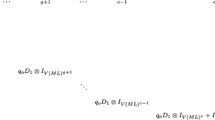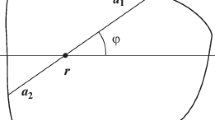Abstract
We study the cell performance characteristics for a mobile network in which the user service rate depends on the area of the cell where the user is located. The division of the cell into zones is determined by the signal quality and depends on the distance to the base station and the presence of obstacles and interference for the radio signal. The incoming flow of requests is described by a marked Markovian arrival process, where the request type corresponds to the zone where it is generated. Being served, the requests can move between zones, resulting in a change in their types. The possibility of fluctuations in the flow and service process parameters under the influence of exogenous random disturbances (random environment) is taken into account. The importance of taking into account the dependence of parameters on the state of the random environment and the possibility of using the results for solving optimization problems are numerically illustrated.







Similar content being viewed by others
REFERENCES
Lee, Y.L. et al., Recent advances in radio resource management for heterogeneous LTE/LTE-A networks, IEEE Commun. Surv. & Tutorials, 2014, vol. 16, no. 4, pp. 2142–2180.
Cao, P. and Xie, J., Optimal control of a multiclass queueing system when customers can change types, Queueing Syst., 2016, vol. 82, no. 3–4, pp. 285–313.
Dudin, S. and Kim, C., Analysis of multi-server queue with spatial generation of customers and service rate depending on customers’ location as a model of cell operation, IEEE T. Commun., 2017, vol. 65, pp. 4325–4333.
Gnedenko, B.V. and Kovalenko, I.N., Vvedenie v teoriyu massovogo obsluzhivaniya (Introduction in Queueing Theory), Kiev: KVIRTU, 1963.
Dudin, A. et al., Priority retrial queueing model operating in random environment with varying number and reservation of servers, Appl. Math. Comput., 2015, vol. 269, pp. 674–690.
He, Q.M., Queues with marked customers, in Advances in Applied Probability, 1996, pp. 567–587.
Chakravarthy, S.R., The batch Markovian arrival process: a review and future work, Adv. Probab. Theory Stochastic Process., 2001, vol. 1, pp. 21–49.
Lucantoni, D.M., New results on the single server queue with a batch Markovian arrival process, Commun. Stat. Stochastic Models, 1991, vol. 7, no. 1, pp. 1–46.
Vishnevskii, V.M. and Dudin, A.N., Queueing systems with correlated arrival flows and their applications to modeling telecommunication networks, Autom. Remote Control, 2017, vol. 78, no. 8, pp. 1361–1403.
Graham, A., Kronecker Products and Matrix Calculus with Applications, New York: Courier Dover Publ., 2018.
Neuts, M.F., Matrix-Geometric Solutions in Stochastic Models: an Algorithmic Approach, Courier Corp, 1994.
Asmussen, S., Applied Probability and Queues. Vol. 51 , New York: Springer Sci. & Bus. Media, 2008.
Kim, C. et al., Tandem queueing system with infinite and finite intermediate buffers and generalized phase-type service time distribution, Eur. J. Oper. Res., 2014, vol. 235, no. 1, pp. 170–179.
Dudin, A. et al., Multi-server queueing system with a generalized phase-type service time distribution as a model of call center with a call-back option, Ann. Oper. Res., 2016, vol. 239, no. 2, pp. 401–428.
Brazenas, M., Horvath, G., and Telek, M., Parallel algorithms for fitting Markov arrival processes, Perform. Eval., 2018, vol. 123, pp. 50–67.
Buchholz, P. and Kriege, J., Fitting correlated arrival and service times and related queueing performance, Queueing Syst., 2017, vol. 85, pp. 337–359.
Blume, A., Buchholz, P., and Kriege, J., Parallelization of EM-algorithms for Markovian arrival processes, Lect. Notes Comput. Sci., 2020, vol. 12040, pp. 173–189.
Daduna, H., Graph-based mobility models: asymptotic and stationary node distribution, Lect. Notes Comput. Sci., 2020, vol. 12040, pp. 155–172.
Leo, Y. et al., Call detail records to characterize usages and mobility events of phone users, Comput. Commun., 2016, vol. 95, pp. 43–53.
Ramaswami, V. and Lucantoni, D.M., Algorithms for the multi-server queue with phase type service, Stochastic Models, 1985, vol. 1, no. 3, pp. 393–417.
Kim, C. et al., Queueing system \(MAP/PH/N/N+R \) with impatient heterogeneous customers as a model of call center, Appl. Math. Model., 2013, vol. 37, no. 3, pp. 958–976.
Kim, C. et al., Mathematical models for the operation of a cell with bandwidth sharing and moving users, IEEE Trans. Wireless Commun., 2020, vol. 19, no. 2, pp. 744–755.
Funding
This work was supported by the National Natural Science Foundation of China, project no. 61262083 and the RUDN University Strategic Academic Leadership Program.
Author information
Authors and Affiliations
Corresponding authors
Additional information
Translated by V. Potapchouck
Rights and permissions
About this article
Cite this article
Bin Sun, Dudin, S.A., Dudina, O.S. et al. A Customer Service Model in an Adaptive-Modulation Mobile Communication Cell with Allowance for Random Environment. Autom Remote Control 82, 812–826 (2021). https://doi.org/10.1134/S0005117921050064
Received:
Revised:
Accepted:
Published:
Issue Date:
DOI: https://doi.org/10.1134/S0005117921050064




